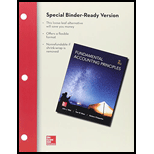
Concept Introduction:
Forms of the Business Organizations:
A business can be formed into any of the business organization types like,
• Partnership: Partnership is one of the types of business origination. Under the partnership, two or more individuals agree to form a business together and share losses and profits in the predetermined ratio.
• Corporate form: Corporate form is the most complicated and wider form of business organization. It creates a separate legal identity of the business and allows the business to raise funds through public issue.
• Sole proprietorship: Amongst all of the business organization forms, a sole proprietorship is the simplest form. Under a sole proprietorship, the business is owned and controlled by a single person.
To determine: The form of business organization, tax liability and one advantage of the form of business organization for the owner for each of the given case.
Want to see the full answer?
Check out a sample textbook solution
Chapter 12 Solutions
Loose Leaf for Fundamentals of Accounting Principles and Connect Access Card
- I need help with this financial accounting question using standard accounting techniques.arrow_forwardI need help with this general accounting question using standard accounting techniques.arrow_forwardI am trying to find the accurate solution to this financial accounting problem with the correct explanation.arrow_forward
- Please help me solve this financial accounting question using the right financial principles.arrow_forwardPlease explain the solution to this financial accounting problem with accurate explanations.arrow_forwardPlease explain the correct approach for solving this financial accounting question.arrow_forward
- Please provide the answer to this financial accounting question with proper steps.arrow_forwardI am searching for the correct answer to this financial accounting problem with proper accounting rules.arrow_forwardI need help finding the accurate solution to this financial accounting problem with valid methods.arrow_forward
- I am looking for help with this general accounting question using proper accounting standards.arrow_forwardCan you explain this financial accounting question using accurate calculation methods?arrow_forwardPlease explain the correct approach for solving this financial accounting question.arrow_forward

 AccountingAccountingISBN:9781337272094Author:WARREN, Carl S., Reeve, James M., Duchac, Jonathan E.Publisher:Cengage Learning,
AccountingAccountingISBN:9781337272094Author:WARREN, Carl S., Reeve, James M., Duchac, Jonathan E.Publisher:Cengage Learning, Accounting Information SystemsAccountingISBN:9781337619202Author:Hall, James A.Publisher:Cengage Learning,
Accounting Information SystemsAccountingISBN:9781337619202Author:Hall, James A.Publisher:Cengage Learning, Horngren's Cost Accounting: A Managerial Emphasis...AccountingISBN:9780134475585Author:Srikant M. Datar, Madhav V. RajanPublisher:PEARSON
Horngren's Cost Accounting: A Managerial Emphasis...AccountingISBN:9780134475585Author:Srikant M. Datar, Madhav V. RajanPublisher:PEARSON Intermediate AccountingAccountingISBN:9781259722660Author:J. David Spiceland, Mark W. Nelson, Wayne M ThomasPublisher:McGraw-Hill Education
Intermediate AccountingAccountingISBN:9781259722660Author:J. David Spiceland, Mark W. Nelson, Wayne M ThomasPublisher:McGraw-Hill Education Financial and Managerial AccountingAccountingISBN:9781259726705Author:John J Wild, Ken W. Shaw, Barbara Chiappetta Fundamental Accounting PrinciplesPublisher:McGraw-Hill Education
Financial and Managerial AccountingAccountingISBN:9781259726705Author:John J Wild, Ken W. Shaw, Barbara Chiappetta Fundamental Accounting PrinciplesPublisher:McGraw-Hill Education





